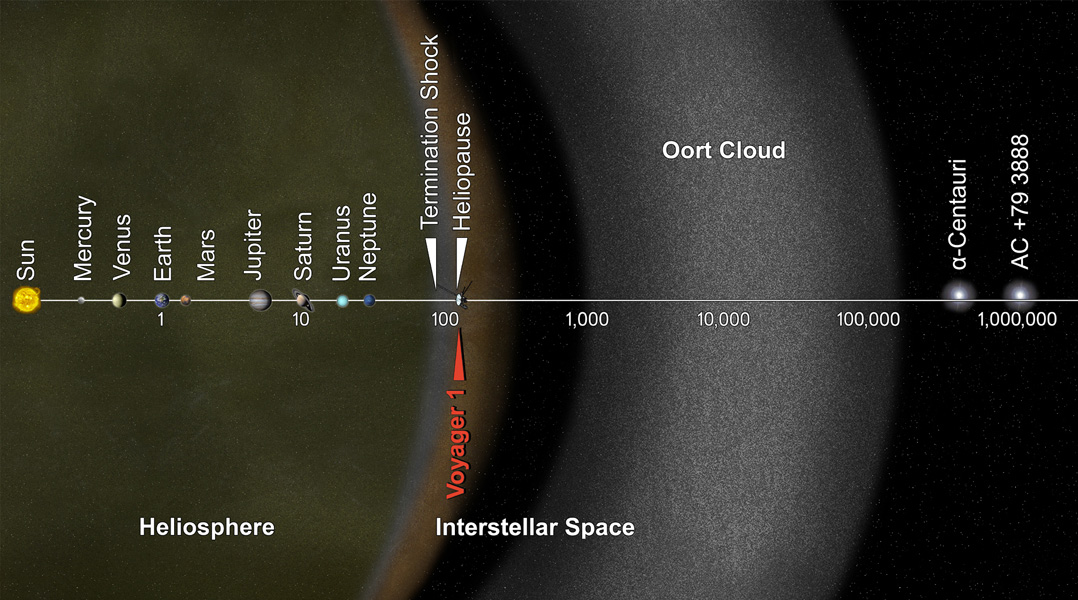Voyager 1 Exits the Heliosphere (NOT the Solar System)
October 2, 2013
After an amazing 35-year trek, the Voyager 1 spacecraft has crossed the threshold of a vast region of space called the heliosphere, scientists at NASA’s Jet Propulsion Laboratory (JPL) have announced. Did the little craft that just keeps going also exit the solar system? The answer is: not really, despite many reports in news media. Nevertheless, Voyager’s accomplishment is still a big deal.
The heliosphere is a teardrop-shaped region of space that holds the sun and all the planets. The heliosphere is created by the solar wind–a stream of electrically charged gas particles given off by the sun. The sun and the heliosphere are traveling together through interstellar space (the space between the stars), like an air bubble through water. So by leaving the heliosphere, Voyager 1 has gone where no human-made object has gone before–to interstellar space. JPL scientists said this milestone occurred on about August 25, 2012, when Voyager was about 11.5 billion miles (18.5 billion kilometers) from Earth.
But Voyager 1 has not really left the solar system. That’s because the solar system also includes a large band of objects even farther out in space called the Oort cloud. The Oort cloud, which is held by the gravity of the sun, begins about 500 billion miles (800 billion kilometers) from the sun.

The scale bar in the illustration is measured in astronomical units (AU's). Each AU equals the distance from the sun to the Earth. (NASA/JPL-Caltech)
Because the Oort cloud orbits the sun, it is in the solar system. But it is also in interstellar space. Why is that? In short, most scientists believe that the edge of the heliosphere and the edge of the solar system are not the same. The pressure of the solar wind decreases as it speeds through space because the charged particles spread out. At the edge of the heliosphere, the pressure of the solar wind equals the pressure from the interstellar medium (the charged particles streaming through interstellar space). The density of these charged particles is different from those in the solar wind. This difference enabled scientists to determine when and where Voyager 1 crossed into interstellar space.
To actually leave the solar system, Voyager 1 would still need to cross the Oort cloud. Assuming the spacecraft survives, it would take another 200 to 300 years to even reach the Oort cloud and about another 30,000 years to exit the far side, the most commonly recognized edge of the solar system. If Voyager makes it this far, we will probably never know. Voyager 1 is expected to run out of nuclear fuel and to cease collecting data and communicating with Earth in the mid-2020′s.
Launched in 1977, Voyager 1 and Voyager 2 have lasted longer and traveled farther than any other space probes in history. Voyager 2 is now about 9.5 billion miles (15.3 billion kilometers) from the sun, going in the opposite direction from Voyager 1.

The two Voyager spacecraft explore the outer edges of the heliosphere, a vast, tear-drop-shaped region of space that contains the sun and planets, in an artist's illustration. Voyager 1 has now left the heliosphere. (NASA/JPL-Caltech)
Additional information:
- Listen to a recording of the sounds of charged particles vibrating in interstellar space made by Voyager 1 here.
- The Voyager site at the Jet Propulsion Laboratory
- The Voyager site at NASA
Additional World Book articles:
- Space exploration
- The Thirty-Year Journey of Voyagers 1 & 2 (A Special Report)
- Astronomy (1979) (A Back in Time article)
- Astronomy (1989) (A Back in Time article)
- Space Exploration (1977) (A Back in Time article)
- Space Exploration (1979) (A Back in Time article)


